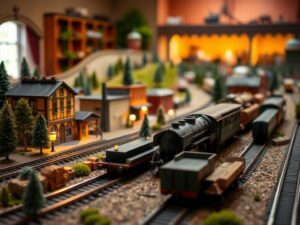Guide to Track Maintenance Tools for HO Scale Modelers
Guide to Track Maintenance Tools for HO Scale Modelers
A Hobbyist’s Guide to Track Maintenance Tools for HO Scale Modelers
Welcome aboard! Stepping into the world of model railroading is like entering a magical realm where you build miniature worlds and bring stories to life through intricate details and meticulous care. One of the most rewarding aspects of this hobby is witnessing the seamless movement of your little trains around your meticulously crafted layout.
But just like real railroads, our HO scale tracks need regular attention to keep everything running smoothly. This is where HO scale track maintenance tools come into play â essential instruments for ensuring consistent power delivery, minimizing derailments, and extending the life of your precious track.
This guide dives deep into the world of HO scale track care tools, providing insights that cater to both new enthusiasts and seasoned veterans alike. Let’s embark on this journey together!
Why Track Maintenance Matters:
Think of your model railroad layout like a tiny city. Just as roads require paving, patching, and cleaning for smooth traffic flow, our miniature railway lines need similar care. Over time, factors like dust accumulation, electrical grime, and physical wear can impede conductivity, causing inconsistent train movement or even derailments. Regular maintenance is crucial for:
- Consistent Electrical Performance: Dirty tracks disrupt the current flow, leading to slow speeds, stalled trains, or flickering lights.
- Preventative Care: Identifying and addressing minor issues early on prevents larger problems that could damage your track and rolling stock.
- Enhanced Enjoyment: Smooth, clean tracks ensure your trains run reliably and visually appealing, maximizing your modeling experience.
Essential HO Scale Track Maintenance Tools for Every Workshop:
Let’s equip you with the essentials for taking excellent care of your HO scale railway!
1. Track Cleaning Tools:
Keeping your track clean is the foundation of good performance. The accumulation of dirt and debris, even tiny particles like metal filings or dust, can interfere with current flow. Here are two effective cleaning tools:
-
Cleaning Car (DCC Friendly): These dedicated vehicles have pads equipped with a fine scrubbing material that cleans tracks as they pass over them. Some models are even designed to be DCC-controlled, allowing for automated cleaning runs during your train sessions.
- Expert Tip: Cleaning cars work best after running a short “training” session with a test engine to remove loosely attached debris.
-
Hand Track Cleaner (With Tweezers): For intricate sections or detailed cleaning around track turnouts and points, use a dedicated hand cleaner equipped with tweezers. They come in different configurations for narrow gauges or broader HO scale tracks.
- Expert Tip: Use specialized cleaners designed specifically for model train tracks to prevent damage.
2. Tools for Inspection and Adjustment:
Taking the time to inspect your track regularly is crucial for identifying potential issues before they escalate.
-
Track Gauge Measuring Tool: Keep your HO scale track properly aligned with this tool. A consistent gauge ensures proper wheel-to-rail contact for smooth operation and prevents derailments.
- Expert Tip: Use a sliding gauge with both inch and metric measurements for precise accuracy.
-
Turnout Tools (Adjusting Gauge, Cleaning): Dedicated tools allow you to precisely adjust turnout mechanisms and maintain track alignment for smooth switching operations. These tools typically include adjustable screwdrivers and cleaning rods designed for specific types of turnouts.
- Expert Tip: Learn the proper sequence for adjusting your specific type of turnout mechanism, as overtightening can damage parts.
3. Track Repair Essentials:
Minor track damage happens to the best of us! Having the right repair tools on hand will allow you to fix problems quickly and keep things running smoothly.
* HO Scale Rail Bonding Nippers: Designed for removing faulty rail bonds and applying new ones with precision. Properly bonded rails ensure efficient power transfer and minimize short circuits.
* Expert Tip: Always use these nippers in a controlled environment, as sparks can occur.
- Plastic Track Soldering Iron & Splices: These allow you to join plastic track sections reliably and provide additional support where needed. Always refer to the manufacturer’s instructions for proper soldering technique.
Choosing Quality Tools Makes a Difference:
Donât skimp on tools when it comes to HO scale track maintenance. While there are budget-friendly options available, investing in quality instruments that offer durability and precision will save you time and frustration in the long run. Look for brands known for reliability, like Atlas, Bachmann, Kadee, Woodland Scenics, or even professional model train suppliers in your region.
Beyond the Basics: Advanced Track Maintenance Tools:
As you gain experience and explore more advanced modeling techniques, consider these tools to take your track maintenance skills to the next level:
* Micro Solder and Flux Pencils: Essential for precise soldering repairs on smaller gauge rails or intricate electronic components within DCC systems.
* Laser Track Aligner: These innovative devices use lasers to project a straight line along your tracks, helping you visualize alignment issues with incredible accuracy.
* Rail Lubricator/Oiler: Apply specialized lubricant designed for model railway track systems. This helps reduce friction and promote smoother wheel-rail contact, particularly beneficial in humid environments.
Tips for Efficient Track Maintenance:
Here are some tips to streamline your maintenance routine:
-
Develop a Regular Cleaning Schedule: Depending on usage frequency and environmental factors (e.g., dust), aim for monthly track cleaning sessions at minimum.
-
Use Gentle Pressure: When using cleaning tools, avoid excessive pressure that could damage the delicate rails or sleepers.
-
Work in Sections: Tackle track cleaning and repair tasks section by section to avoid unnecessary clutter and focus your efforts.
-
Organize Your Toolkit: Store your tools in a dedicated case or compartment for easy access and prevent accidental damage during transportation.
Keep Learning, Experiment, and Share!:
The world of HO scale track maintenance is constantly evolving, with new technologies and techniques emerging regularly. Stay curious! Attend local model railroad clubsâ meetings, participate in online forums, read magazines, and never stop experimenting to find what works best for your unique setup. Remember, we are a community â share your knowledge and experiences with fellow hobbyists. After all, the most rewarding part of model railroading is learning, creating, and sharing the passion with others!
Now that you have a deeper understanding of essential HO scale track maintenance tools, equip yourself, get cleaning, and watch those trains run smoother than ever before!




